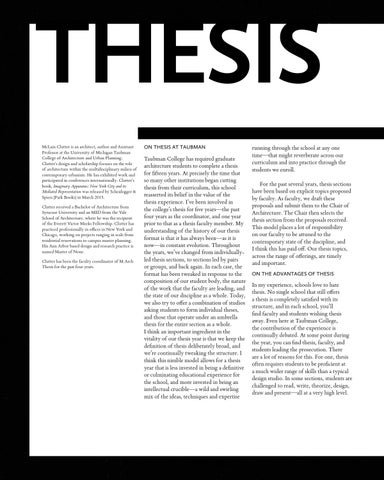THESIS McLain Clutter is an architect, author and Assistant Professor at the University of Michigan Taubman College of Architecture and Urban Planning. Clutter’s design and scholarship focuses on the role of architecture within the multidisciplinary milieu of contemporary urbanism. He has exhibited work and participated in conferences internationally. Clutter’s book, Imaginary Apparatus: New York City and its Mediated Representation was released by Scheidegger & Spiess (Park Books) in March 2015. Clutter received a Bachelor of Architecture from Syracuse University and an MED from the Yale School of Architecture, where he was the recipient of the Everett Victor Meeks Fellowship. Clutter has practiced professionally in offices in New York and Chicago, working on projects ranging in scale from residential renovations to campus master planning. His Ann Arbor based design and research practice is named Master of None. Clutter has been the faculty coordinator of M.Arch Thesis for the past four years.
ON THESIS AT TAUBMAN
Taubman College has required graduate architecture students to complete a thesis for fifteen years. At precisely the time that so many other institutions began cutting thesis from their curriculum, this school reasserted its belief in the value of the thesis experience. I’ve been involved in the college’s thesis for five years—the past four years as the coordinator, and one year prior to that as a thesis faculty member. My understanding of the history of our thesis format is that it has always been—as it is now—in constant evolution. Throughout the years, we’ve changed from individuallyled thesis sections, to sections led by pairs or groups, and back again. In each case, the format has been tweaked in response to the composition of our student body, the nature of the work that the faculty are leading, and the state of our discipline as a whole. Today, we also try to offer a combination of studios asking students to form individual theses, and those that operate under an umbrella thesis for the entire section as a whole. I think an important ingredient in the vitality of our thesis year is that we keep the definition of thesis deliberately broad, and we’re continually tweaking the structure. I think this nimble model allows for a thesis year that is less invested in being a definitive or culminating educational experience for the school, and more invested in being an intellectual crucible—a wild and swirling mix of the ideas, techniques and expertise
60
running through the school at any one time—that might reverberate across our curriculum and into practice through the students we enroll. For the past several years, thesis sections have been based on explicit topics proposed by faculty. As faculty, we draft these proposals and submit them to the Chair of Architecture. The Chair then selects the thesis section from the proposals received. This model places a lot of responsibility on our faculty to be attuned to the contemporary state of the discipline, and I think this has paid off. Our thesis topics, across the range of offerings, are timely and important. ON THE ADVANTAGES OF THESIS
In my experience, schools love to hate thesis. No single school that still offers a thesis is completely satisfied with its structure, and in each school, you’ll find faculty and students wishing thesis away. Even here at Taubman College, the contribution of the experience is continually debated. At some point during the year, you can find thesis, faculty, and students leading the prosecution. There are a lot of reasons for this. For one, thesis often requires students to be proficient at a much wider range of skills than a typical design studio. In some sections, students are challenged to read, write, theorize, design, draw and present—all at a very high level.
